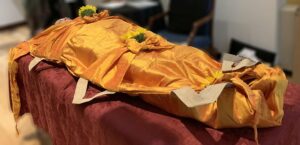But What Should I Wear to My Own Funeral?

Photo by Lisa Feldstein
Shrouds have been part of human death rituals for thousands of years. Sometimes called “winding sheets” because they may simply be sheets that are wrapped around the deceased before burial, shrouds appear in the funereal customs of cultures and religious practices all over the world. Use of shrouds decreased in western cultures in the 20th Century, but with “green” burial gaining currency, there has been a resurgence of interest in their use.
Cultural and religious usage of shrouds is widespread. For example, Jewish burial laws mandate that the deceased be able to become part of the earth again, and cotton and linen shrouds allow natural decomposition of the corpse. Judaism and Islam both require shrouding the dead, mandating that all shrouds be hand-sewn and simple, to show that we are all the same in death. Shrouds were common in Christianity for much of its history, and are still required for Orthodox Christian burials. Hindus shroud bodies before laying them on funeral pyres. Korean culture has called for shrouding since ancient times, a practice that has been retained even as the Korean population becomes more diverse in its religious affiliations. Zoroastrians shroud bodies for the funeral procession to the Tower of Silence, but the shroud is removed to allow vultures free access to the body. The most sumptuous silk fabrics are reserved for use in the famadihana ceremonies of the Merina and Malagasy peoples of Madagascar, a sacred ritual held every five to seven years in which ancestor’s corpses are exhumed and redressed in fresh shrouds. Tibetan Bardo shrouds are imprinted with all the blessing mantras that are said to “liberate upon physical contact,” and are put on the bodies of those who are very close to the moment of death, or are recently deceased; the shroud is used whether the body is to be buried or cremated. Some First Nation and Native American tribes also use shrouds as part of preparing corpses for disposition.
Most funeral homes can provide families with shrouds if they request them, but it is worth knowing that shroud options are both diverse and readily available. Like the range of options in price and design for coffins, shrouds range from those constructed of simple, unbleached cotton, to elaborate, custom-designed silk options. Below is a list of some of the places that offer shrouds. In addition, if your client has specific religious requirements for a shroud, their religious community is probably the best place to identify providers.
For those who are handy with a needle and thread, patterns are available to help ensure sizing is adequate, and that there are enough ties and carrying handles. The Canadian Integrative Network for Death Education and Alternatives (CINDEA) offers a variety of free patterns.
For simple cotton shrouds there are a host of options and prices. Etsy offers an extensive selection, priced from $50-$500+. Some people buy these and use them as blank canvases, painting, block-printing, dying, or otherwise decorating them for the deceased. Bamboo fabric is less common, but available. Green Burial Council member Kinkaraco, offers everything from simple cotton to custom silk and mud cloth. Virginia Marcolin, founder of Sanctum, creates high-quality organic fabrics which are soft to the touch and biodegradable. She tints the fabrics with colorful, non-toxic plant dyes and infuses them with my proprietary plant-based antibacterial formula, which inhibits germ growth and neutralizes malodor, replacing it with pleasant, fresh scents of nature. For another green option, one can find shrouds repurposed from used clothing. Wool is an unusual fabric for shrouds, but can be found. There are even sailcloth shrouds available for burial at sea. Should you or a client need assistance on how to wrap a body in a shroud, this site offers helpful information on types, limitations, and how to shroud the deceased.
Updates 4/9/24
